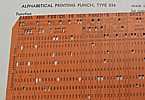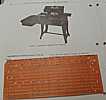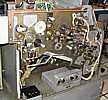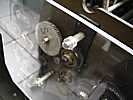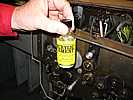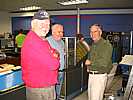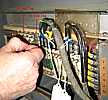Schedule November 2006
return to main 1401 Restoration Page
go to Team Bios
Contents:
Wednesday November 01 - general,
Thursday November 02 - Tape Team,
Wednesday November 8 - general ,
Thursday November 9 - Tape Team,
Saturday November 11 - 2nd Saturday,
Wednesday November 15 - general,
Thursday November 16 - Tape Team, Sunday
Wednesday November 22 - general,
Thursday November 23 - Tape Team,
Saturday November 25 - 4th Saturday
Wednesday November 29 - general,
Thursday November 30 - Tape Team,
Wednesday November 01 - general,
Thursday November 02 - Tape Team
Regards,
Wednesday November 8 - general
Thursday November 9 - Tape Team
Saturday November 11 - 2nd Saturday
I took a movie the the test - but tipped the camera on end and the result is a tape drive
lying on its side :-(( - Next time.
OK Allen and Glenn, time to put the last four tape drives together and run SORT 7 ;-))
Tim Coslet suggested that Mike Cheponis propose a "pin driver" circuit.
2. The Hammer Drivers put more current through the fuse than its rating
but only for a short time. I once worked on a bug on a 2821 Printer
Control where there was a cold flow backpanel short between the T5
hammer fire line and the carriage 2 stop brush. The T5 pulse was a 5MS
pulse but the carriage 2 stop bursh was 50MS long. The printer would
print fine until the carriage came to a 2 hole in the tape and then it
would blow the fuses in position 50 thru 59. I wrote about this in
story # 41.
Van Gardner
Wednesday November 15 - general
Thursday November 16 - Tape Team
Today the spirits of chaos ran amuck in the 1401 room. I am not sure of
any of the measurements or observations that we made, so I will report
only the most basic.
P.S. Tape Load failed once. The tape was not drawn down into the left
vacuum channel.
Sunday November 19
This object code was the result of a working program on ROPE.
Because there is no assembler currently running on "our" 1401, I decided to try to keypunch the object code.
I successfully keypunched 10 cards in about an hour. Unfortunately, the text is a little tough to type,
consisting of lines such as
Ron Crane thinks it would be nice to code a software UART in the 1401 to read an (ASCII to) BCD serial bit stream from
a PC, and punch the result from the 1402 card punch. Randy Thelen suggested placing the software
UART into the loader, eliminating the need for the 1402 card punch.
I presume we would have to have to have a transmission verifications scheme to detect errors.
I think it would be super to get either SPS or AutoCoder working on the 1401 - and save work?
Wednesday November 22 - general
from Bob Feretich
The "new electronic box" will be able to emulate 4 drives if it can be made to perform to specifications.
The firmware, kernel driver, and PC application program need to be completed. It was placed on the back burner
to focus on TAU debug. (The box was functional enough to assist with that.)
Cleaned up lab benches and floor, and created bureaucratic clipboard form for "pre-donation" materials coming in to room.
(I noticed Grant's newly obtained manuals in a box.)
Mike Melas, from IBM Almaden, dropped by. (He worked on the 1401's 7770 "Audio Response Unit",
which gave voice to teller machines.) He'll return another Weds, when everyone is there.
Hope you enjoyed your Thxgiving!
- Robert
Thursday November 23 - Tape Team
Saturday November 25 - 4th Saturday
We noticed a "life time" (about 12,000 cards ;-)) supply of 5081 cards by the key punch.
Jeff and Ed played with Jeff's old HeathKit scope :-))
Ron was looking about at the intermittent card read error - wants to scope brush and circuit breaker timing this coming Wednesday.
Hope someone brings in small iron filings Wednesday to see if we are writing on the mag tape "C" track.
Wednesday November 29 - general
Thursday November 30 - Tape Team
I came in Saturday and entertained some visitors from the Vintage Computer Conf.
I tried to do some TAU debug, but the 729 started streching tape again. The vacuum column switches need to be calibrated. About every forth time the tape gets sucked into the vacuum column, a stretch occurs. The symptom is the same as last time, except that the left column is doing it.
Bob
TAU Debug Status 11/9/06:
Fixed a timing problem regarding setting the TAU R-W Reg. Now the "Read
Tape" instructions work!
Could not reproduce the "Backspace Tape" problem that was reported
Wednesday. The drive moved tape backwards as it is supposed to do.
Ran several tape diagnostic decks. Intermittent errors occurred (reader
check, printer check, and tape error).
* 5000 Card to Tape - Passed
* 5030 Backspace Skip - Passed
* 5040 Move Tape - No errors, but it runs forever. (probably an
error in the deck)
* 5050 Load Tape - Pass (on second attempt).
* 5080 VRC Check - Fails, reading does not cause errors when they
are expected. Data is received correctly, but the Tape Error
indicator either doesn't get set or does not cause a branch.
* 5500 IRG Check - replaced a bad card in deck. Now, tape moves, but
nothing prints. Then tape stops. Gets consistent reader checks.
In early runs, I thought I saw some 'R's being read as 'J's, but the
problem went away.
We have a solid error on the VRC Diag. After that it seems that we need
to shoot intermittent errors.
Regards,
Bob

Some lowdown -
Some lowdown @#$%^^&* redecorated my tool box. Of course all eyes turn to Ron Williams
on occasions like this. And he looks so guilty even when nothing is happening!!
Looks as though Bob Erickson relented ;-))

All forgiven
Ron Crane, Tim Coslet and Ed Thelen talked some about a request for an SMS card tester. (Both the IBM 1620
and the IBM 1401 use the SMS format cards.)
The circuitry and control for "pin drivers" is likely to be "interesting".
The exceptional cards might include printer hammer drivers (70 volts at briefly 1 amp?)
and core sense and tape preamplifier cards?
John Van Gardner adds
1. The CTDL cards in the 1401 and the SDTDL cards in the NAND TAU-9 use
different pins for DC voltages. You can verify this by looking at the
card diagrams for the CTDL Trigger CW-- and the SDTDL Trigger DHF. The
Overlap Engineers forgot this when they put some CTDL cards in the TAU
gate on the first Field B/M I installed in story # 33.
TAU Debug Status (Ron W. & me): [and Grant Saviers]
Sunday
Regards,
Bob Feretich
Ed Thelen experimented with keypunching the object deck of a routine to generate Pi.
This version is intended for an 8,000 character memory 1401, outputting 2,000 digits of Pi.
This shorter version avoids the use of the known
defective upper 8,000 of our 16,000 character memory 1401.
M9'/256H0890/02AR98105CR9Y105B675TB000 L038800,770777,778785,792797104000010
and there are about 150 more cards yet to go.
I decided to do other things with my life.
Key punching the source deck already debugged in ROPE :-))
from Jeff Stutzman - 12:01 AM Wednesday Nov 22
Greetings,
I put four 4' X 12' sheets of Plexiglas into the CHM shop, they are real long! ;-)
There is also a full 1" thick plywood sheet to use for support while cutting.
We might want to make some paper patterns before fragmenting full sheets.
If we need more, I might be able to get a few 4' X 4' scraps for smaller cuts.
Enjoy.
from Robert Garner
Allen finished the tape drive components rebuild at Grant's shop on Monday.
He is hauling all the motors, clutches, and shafts back to the CHM. We may soon have a few more 729 drives running.
It was just me in on Weds! :-(
Present were Ron Williams, Jeff Stutzman and Ed Thelen
That is better than a security blanket !!
Trying to keypunch position sensitive code into unmarked cards is worse than no fun !!
Lovely - vacuum tubes and all :-))
The major problem was a *very* hard to twist shaft - solved by - you guessed it - WD-40 ;-))
Alternatively, we could try to read a known well written tape. If the "C" track shows up on that,
then for some reason the "C" track is not being written on the test tape.
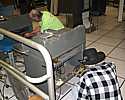
Here they are comparing the two keypunches (not identical) to try to verify that
they are still on the right track.

Frank King and Chuck Kantman working on the card feed mechanism of the 083 sorter. It doesn't work very well.
Go to December 2006
go to Team Bios
